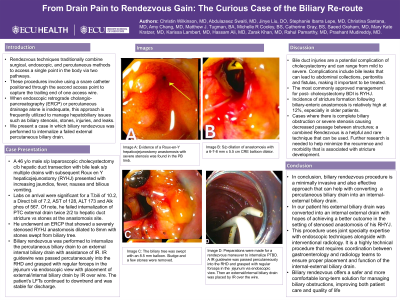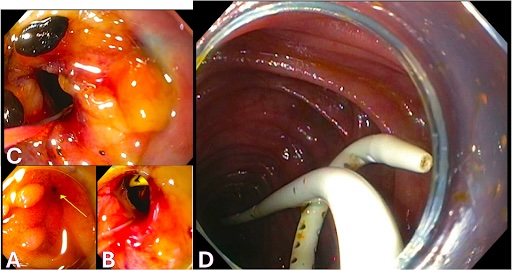Sunday Poster Session
Category: Interventional Endoscopy
P1113 - From Drain Pain to Rendezvous Gain: The Curious Case of the Biliary Re-Route
Sunday, October 27, 2024
3:30 PM - 7:00 PM ET
Location: Exhibit Hall E

Has Audio

Christin Wilkinson, MD
East Carolina University
Greenville, NC
Presenting Author(s)
Christin Wilkinson, MD1, Jinye Liu, DO2, Abdulazeez Swaiti, MD1, Stephanie Ibarra Lepe, MD2, Christina Santana, MD2, Amy Chang, MD2, Matthew Tugman, BA3, Michelle Cooley, BS3, Catherine Gray, BS3, Saeed Graham, MD1, MaryKate Kratzer, MD2, Karissa Lambert, MD4, Hassam Ali, MD1, Zarak Khan, MD4, Rahul Pamarthy, MD1, Prashant Mudireddy, MD4
1East Carolina University, Greenville, NC; 2East Carolina University Medical Center, Greenville, NC; 3East Carolina University Brody School of Medicine, Greenville, NC; 4East Carolina Gastroenterology, Greenville, NC
Introduction: Rendezvous techniques traditionally combine surgical, endoscopic, and percutaneous methods to access a single point in the body via two pathways. These procedures involve using a snare catheter positioned through the second access point to capture the trailing end of one access wire. When endoscopic retrograde cholangio-pancreatography (ERCP) or percutaneous drainage alone is inadequate, this approach is frequently utilized to manage hepatobiliary issues such as biliary stenosis, stones, injuries, and leaks. We present a case in which biliary rendezvous was performed to internalize a failed external percutaneous biliary drain.
Case Description/Methods: A 46 y/o male s/p laparoscopic cholecystectomy c/b hepatic duct transection with bile leak s/p multiple drains with subsequent Roux en Y hepaticojejunostomy (RYHJ) presented with increasing jaundice, fever, nausea and bilious vomiting. Labs on arrival were significant for a T.bili of 10.2, a Direct bili of 7.2, AST of 128, ALT 173 and Alk phos of 567. Of note, he failed internalization of PTC external drain twice 2/2 to hepatic duct stricture vs stones at the anastomosis site. He underwent an ERCP that showed a severely stenosed RYHJ anastomosis dilated to 8mm with stones swept from biliary tree. Biliary rendezvous was performed to internalize the percutaneous biliary drain to an external internal biliary drain with assistance of IR. IR guidewire was passed percutaneously into the RHD and grasped with regular forceps in the jejunum via endoscopic view with placement of external/internal biliary drain by IR over wire. The patient’s LFTs continued to downtrend and was stable for discharge.
Discussion: Bile duct injuries are a potential complication of cholecystectomy and can range from mild to severe. Complications include bile leaks that can lead to abdominal collections, peritonitis and fistulas, making it important to be treated. The most commonly approved management for post- cholecystectomy BDI is RYHJ. Incidence of stricture formation following biliary-enteric anastomosis is relatively high at 12%, especially in older patients. Cases where there is complete biliary obstruction or severe stenosis causing decreased passage between structures; a combined Rendezvous is a helpful and rare technique that can be used. Further research is needed to help minimize the recurrence and morbidity that is associated with stricture development.

Disclosures:
Christin Wilkinson, MD1, Jinye Liu, DO2, Abdulazeez Swaiti, MD1, Stephanie Ibarra Lepe, MD2, Christina Santana, MD2, Amy Chang, MD2, Matthew Tugman, BA3, Michelle Cooley, BS3, Catherine Gray, BS3, Saeed Graham, MD1, MaryKate Kratzer, MD2, Karissa Lambert, MD4, Hassam Ali, MD1, Zarak Khan, MD4, Rahul Pamarthy, MD1, Prashant Mudireddy, MD4. P1113 - From Drain Pain to Rendezvous Gain: The Curious Case of the Biliary Re-Route, ACG 2024 Annual Scientific Meeting Abstracts. Philadelphia, PA: American College of Gastroenterology.
1East Carolina University, Greenville, NC; 2East Carolina University Medical Center, Greenville, NC; 3East Carolina University Brody School of Medicine, Greenville, NC; 4East Carolina Gastroenterology, Greenville, NC
Introduction: Rendezvous techniques traditionally combine surgical, endoscopic, and percutaneous methods to access a single point in the body via two pathways. These procedures involve using a snare catheter positioned through the second access point to capture the trailing end of one access wire. When endoscopic retrograde cholangio-pancreatography (ERCP) or percutaneous drainage alone is inadequate, this approach is frequently utilized to manage hepatobiliary issues such as biliary stenosis, stones, injuries, and leaks. We present a case in which biliary rendezvous was performed to internalize a failed external percutaneous biliary drain.
Case Description/Methods: A 46 y/o male s/p laparoscopic cholecystectomy c/b hepatic duct transection with bile leak s/p multiple drains with subsequent Roux en Y hepaticojejunostomy (RYHJ) presented with increasing jaundice, fever, nausea and bilious vomiting. Labs on arrival were significant for a T.bili of 10.2, a Direct bili of 7.2, AST of 128, ALT 173 and Alk phos of 567. Of note, he failed internalization of PTC external drain twice 2/2 to hepatic duct stricture vs stones at the anastomosis site. He underwent an ERCP that showed a severely stenosed RYHJ anastomosis dilated to 8mm with stones swept from biliary tree. Biliary rendezvous was performed to internalize the percutaneous biliary drain to an external internal biliary drain with assistance of IR. IR guidewire was passed percutaneously into the RHD and grasped with regular forceps in the jejunum via endoscopic view with placement of external/internal biliary drain by IR over wire. The patient’s LFTs continued to downtrend and was stable for discharge.
Discussion: Bile duct injuries are a potential complication of cholecystectomy and can range from mild to severe. Complications include bile leaks that can lead to abdominal collections, peritonitis and fistulas, making it important to be treated. The most commonly approved management for post- cholecystectomy BDI is RYHJ. Incidence of stricture formation following biliary-enteric anastomosis is relatively high at 12%, especially in older patients. Cases where there is complete biliary obstruction or severe stenosis causing decreased passage between structures; a combined Rendezvous is a helpful and rare technique that can be used. Further research is needed to help minimize the recurrence and morbidity that is associated with stricture development.

Figure: Figure 1: Image A: Evidence of a Roux-en-Y hepaticojejunostomy anastomosis with severe stenosis was found in the PB limb. This was characterized as severe. Image B: S/p dilation of anastomosis with a 6-7-8 mm x 5.5 cm CRE balloon dilator. Image C: The biliary tree was swept with an 8.5 mm balloon. Sludge and a few stones were removed. Image D: Preparations were made for a rendezvous maneuver to internalize PTBD. A IR guidewire was passed percutaneously into the RHD and grasped with regular forceps in the jejunum via endoscopic view. Then an external/internal biliary drain was placed by IR over the wire.
Disclosures:
Christin Wilkinson indicated no relevant financial relationships.
Jinye Liu indicated no relevant financial relationships.
Abdulazeez Swaiti indicated no relevant financial relationships.
Stephanie Ibarra Lepe indicated no relevant financial relationships.
Christina Santana indicated no relevant financial relationships.
Amy Chang indicated no relevant financial relationships.
Matthew Tugman indicated no relevant financial relationships.
Michelle Cooley indicated no relevant financial relationships.
Catherine Gray indicated no relevant financial relationships.
Saeed Graham indicated no relevant financial relationships.
MaryKate Kratzer indicated no relevant financial relationships.
Karissa Lambert indicated no relevant financial relationships.
Hassam Ali indicated no relevant financial relationships.
Zarak Khan indicated no relevant financial relationships.
Rahul Pamarthy indicated no relevant financial relationships.
Prashant Mudireddy indicated no relevant financial relationships.
Christin Wilkinson, MD1, Jinye Liu, DO2, Abdulazeez Swaiti, MD1, Stephanie Ibarra Lepe, MD2, Christina Santana, MD2, Amy Chang, MD2, Matthew Tugman, BA3, Michelle Cooley, BS3, Catherine Gray, BS3, Saeed Graham, MD1, MaryKate Kratzer, MD2, Karissa Lambert, MD4, Hassam Ali, MD1, Zarak Khan, MD4, Rahul Pamarthy, MD1, Prashant Mudireddy, MD4. P1113 - From Drain Pain to Rendezvous Gain: The Curious Case of the Biliary Re-Route, ACG 2024 Annual Scientific Meeting Abstracts. Philadelphia, PA: American College of Gastroenterology.
